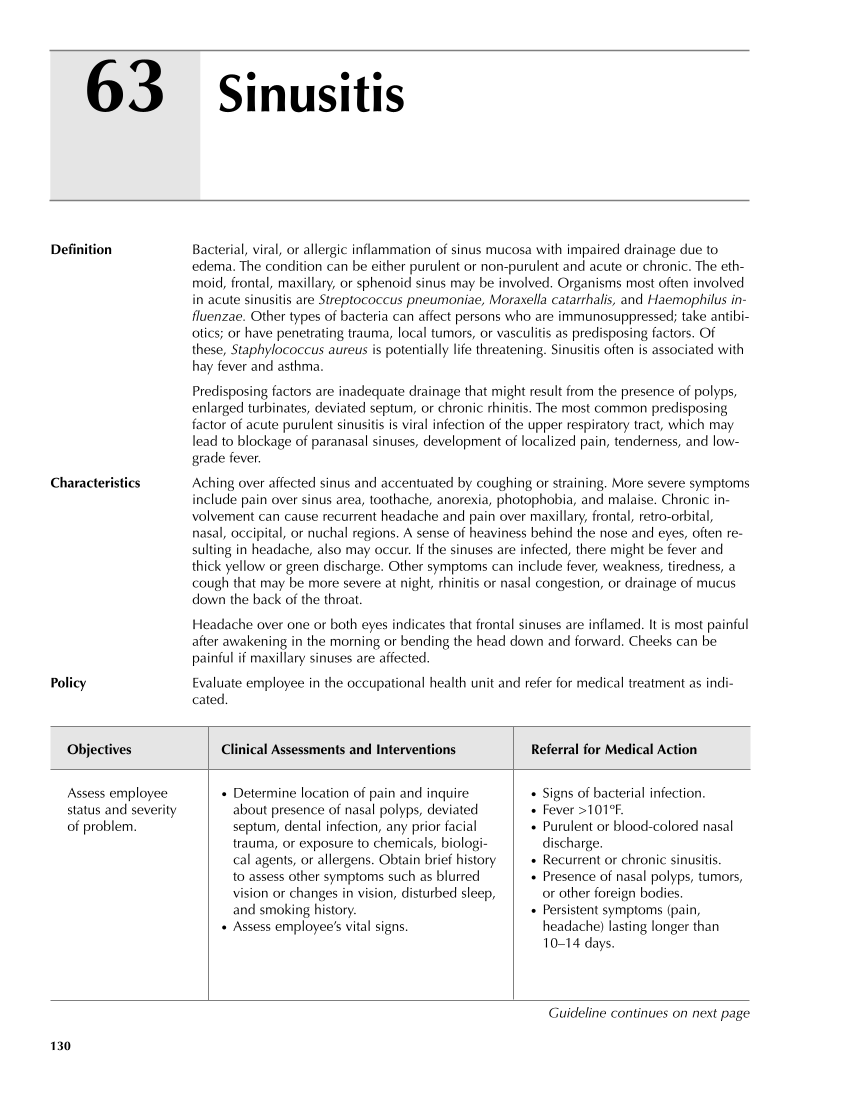63 130 Definition Bacterial, viral, or allergic inflammation of sinus mucosa with impaired drainage due to edema. The condition can be either purulent or non-purulent and acute or chronic. The eth- moid, frontal, maxillary, or sphenoid sinus may be involved. Organisms most often involved in acute sinusitis are Streptococcus pneumoniae, Moraxella catarrhalis, and Haemophilus in- fluenzae. Other types of bacteria can affect persons who are immunosuppressed take antibi- otics or have penetrating trauma, local tumors, or vasculitis as predisposing factors. Of these, Staphylococcus aureus is potentially life threatening. Sinusitis often is associated with hay fever and asthma. Predisposing factors are inadequate drainage that might result from the presence of polyps, enlarged turbinates, deviated septum, or chronic rhinitis. The most common predisposing factor of acute purulent sinusitis is viral infection of the upper respiratory tract, which may lead to blockage of paranasal sinuses, development of localized pain, tenderness, and low- grade fever. Characteristics Aching over affected sinus and accentuated by coughing or straining. More severe symptoms include pain over sinus area, toothache, anorexia, photophobia, and malaise. Chronic in- volvement can cause recurrent headache and pain over maxillary, frontal, retro-orbital, nasal, occipital, or nuchal regions. A sense of heaviness behind the nose and eyes, often re- sulting in headache, also may occur. If the sinuses are infected, there might be fever and thick yellow or green discharge. Other symptoms can include fever, weakness, tiredness, a cough that may be more severe at night, rhinitis or nasal congestion, or drainage of mucus down the back of the throat. Headache over one or both eyes indicates that frontal sinuses are inflamed. It is most painful after awakening in the morning or bending the head down and forward. Cheeks can be painful if maxillary sinuses are affected. Policy Evaluate employee in the occupational health unit and refer for medical treatment as indi- cated. Objectives Clinical Assessments and Interventions Referral for Medical Action Sinusitis ● Signs of bacterial infection. ● Fever 101ºF. ● Purulent or blood-colored nasal discharge. ● Recurrent or chronic sinusitis. ● Presence of nasal polyps, tumors, or other foreign bodies. ● Persistent symptoms (pain, headache) lasting longer than 10–14 days. Assess employee status and severity of problem. ● Determine location of pain and inquire about presence of nasal polyps, deviated septum, dental infection, any prior facial trauma, or exposure to chemicals, biologi- cal agents, or allergens. Obtain brief history to assess other symptoms such as blurred vision or changes in vision, disturbed sleep, and smoking history. ● Assess employee’s vital signs. Guideline continues on next page
Purchased from OEM Press by (ge corporate access). (C) 2013 OEM Health Information, Inc. All rights reserved.












































































































































































































































































































































































































































